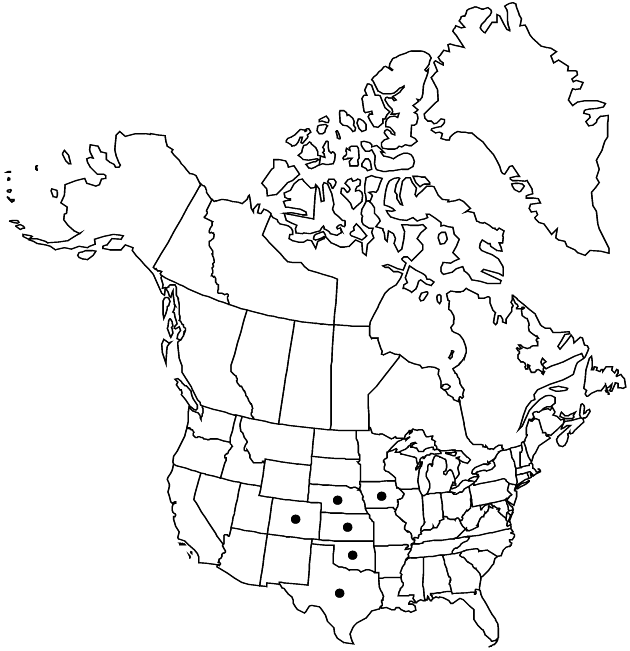Difference between revisions of "Liatris squarrosa var. glabrata"
Rhodora 48: 401. 1946.
FNA>Volume Importer |
FNA>Volume Importer |
||
| Line 26: | Line 26: | ||
|elevation=50–500 m | |elevation=50–500 m | ||
|distribution=Colo.;Iowa;Kans.;Nebr.;Okla.;Tex. | |distribution=Colo.;Iowa;Kans.;Nebr.;Okla.;Tex. | ||
| − | |discussion=<p>Variety glabrata apparently is morphologically discontinuous from var. squarrosa where their ranges closely approach each other (but do not meet) in Texas, and they might be treated as separate species, especially in view of the treatment here of Liatris compacta at specific rank. Within var. squarrosa as treated here, plants along the Gulf coast tend to have much reduced phyllary vestiture (var. alabamensis) and perhaps represent the precursor to var. glabrata. Involucres of var. squarrosa sometimes approach the morphology of L. hirsuta; this appears to be parallel expression of ancestral similarity, because such plants often are long-separated from the geographic range of L. hirsuta. Heads tend to be more numerous and more crowded in var. glabrata than in var. squarrosa.</p> | + | |discussion=<p>Variety glabrata apparently is morphologically discontinuous from <i></i>var.<i> squarrosa</i> where their ranges closely approach each other (but do not meet) in Texas, and they might be treated as separate species, especially in view of the treatment here of <i>Liatris compacta</i> at specific rank. Within <i></i>var.<i> squarrosa</i> as treated here, plants along the Gulf coast tend to have much reduced phyllary vestiture (<i></i>var.<i> alabamensis</i>) and perhaps represent the precursor to <i></i>var.<i> glabrata</i>. Involucres of <i></i>var.<i> squarrosa</i> sometimes approach the morphology of <i>L. hirsuta</i>; this appears to be parallel expression of ancestral similarity, because such plants often are long-separated from the geographic range of <i>L. hirsuta</i>. Heads tend to be more numerous and more crowded in <i></i>var.<i> glabrata</i> than in <i></i>var.<i> squarrosa</i>.</p> |
|tables= | |tables= | ||
|references= | |references= | ||
| Line 50: | Line 50: | ||
|publication year=1946 | |publication year=1946 | ||
|special status= | |special status= | ||
| − | |source xml=https://jpend@bitbucket.org/aafc-mbb/fna-data-curation.git/src/ | + | |source xml=https://jpend@bitbucket.org/aafc-mbb/fna-data-curation.git/src/8f726806613d60c220dc4493de13607dd3150896/coarse_grained_fna_xml/V19-20-21/V21_1306.xml |
|tribe=Asteraceae tribe Eupatorieae | |tribe=Asteraceae tribe Eupatorieae | ||
|genus=Liatris | |genus=Liatris | ||
Revision as of 16:31, 18 September 2019
Stems glabrous. Leaves glabrous. Phyllaries glabrous.
Phenology: Flowering (Jun–)Jul–Aug.
Habitat: Prairies, dunes, flood plains, ditches, roadsides, sandy soils, sandstone hills and outcrops, gravelly hills, clay soils
Elevation: 50–500 m
Distribution

Colo., Iowa, Kans., Nebr., Okla., Tex.
Discussion
Variety glabrata apparently is morphologically discontinuous from var. squarrosa where their ranges closely approach each other (but do not meet) in Texas, and they might be treated as separate species, especially in view of the treatment here of Liatris compacta at specific rank. Within var. squarrosa as treated here, plants along the Gulf coast tend to have much reduced phyllary vestiture (var. alabamensis) and perhaps represent the precursor to var. glabrata. Involucres of var. squarrosa sometimes approach the morphology of L. hirsuta; this appears to be parallel expression of ancestral similarity, because such plants often are long-separated from the geographic range of L. hirsuta. Heads tend to be more numerous and more crowded in var. glabrata than in var. squarrosa.
Selected References
None.
